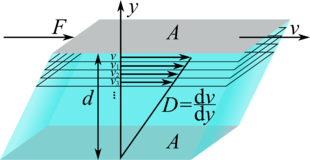Viscosity
Viscosity refers to the viscosity or toughness of liquids and gases (fluids). The higher the viscosity, the thicker (less flowable) the fluid; the lower the viscosity, the thinner (more flowable) it is.
Without further specification, the resistance of the fluid to shear is meant. It is therefore referred to as shear viscosity, to distinguish it from extensional viscosity at elongation and bulk viscosity at uniform pressure. A further distinction is made between dynamic viscosity and kinematic viscosity. The dynamic viscosity is the ratio of shear stress and velocity gradient. The reciprocal of the dynamic viscosity is the fluidity. The dynamic viscosity η 



Particles of viscous fluids are more strongly bound to each other and thus less mobile; this is referred to as internal friction. It results not only from the attractive forces between the particles of the fluid (cohesion). In thinner fluids, viscosity results from momentum flow in the fluid. The viscosity of solids is comparatively high and therefore difficult to determine. Instead of viscosity, terms such as loss factor, storage modulus and loss modulus are used.
The word viscosity goes back to the typically viscous sap of the berries in the plant genus mistletoe (Viscum). Bird glue was obtained from such mistletoe. "Viscous" means "tough like bird glue".
The viscosity appears in the calculation of the viscous stress tensor.

The blue-green liquid on the left is low viscosity like water, the orange one on the right is high viscosity like honey.
Definition
Imagine two plates of area arranged in parallel



The uppermost layer adhering to the plate exerts a tangential force on the layer below. The latter consequently moves with the velocity 
In experiment it can be shown that in the ideal case the force 




This gives the equation
The proportionality constant η 
also 

the connection is

Figure 2: Definition of viscosity: The fluid (blue) is sheared between the stationary plate (bottom) and the moving plate (top).
Units
In the SI system of units, the following applies: A substance located between two plates has the dynamic viscosity 1 Ns/m² if, given a size of the plates of 1 m² and a distance between the plates of 1 m, a force of 1 N is required to move the plates against each other at a speed of 1 m/s. The physical unit of the dynamic viscosity is therefore:
For the SI unit of kinematic viscosity holds:
In practice, in addition to the Pa-s (Pascal second), the thousandth part of the SI unit mPa-s (millipascal second) is also used for the dynamic viscosity for media of low viscosity.
In the CGS system, the dynamic viscosity is measured in Poise (P), where 1 Ns/m² = 1 Pa-s = 10 Poise = 1000 Centipoise = 1000 cP = 1 kg/ms, and the kinematic viscosity in Stokes (St), 1 St = 10-4 m2/s.
The Engler degree is an obsolete unit for viscosity. This unit indicates the viscosity compared to water.
Search within the encyclopedia







![{\displaystyle 1\,{\rm {N}}=[\eta ]\cdot \left({\frac {{\rm {m}}^{2}\,{\rm {m}}}{{\rm {m}}\,{\rm {s}}}}\right)\Rightarrow [\eta ]={\frac {{\rm {N}}\cdot {\rm {s}}}{{\rm {m}}^{2}}}=\mathrm {\frac {kg}{m\cdot s}} ={\rm {1\,Pa\cdot s}}}](https://www.alegsaonline.com/image/3be61a2806ed4c884df41aad9311a8253761841f.svg)
![{\displaystyle [\nu ]={\frac {\rm {m^{2}}}{\rm {s}}}}](https://www.alegsaonline.com/image/ee08d4d423059ee6108c638250193bb53762c4ae.svg)